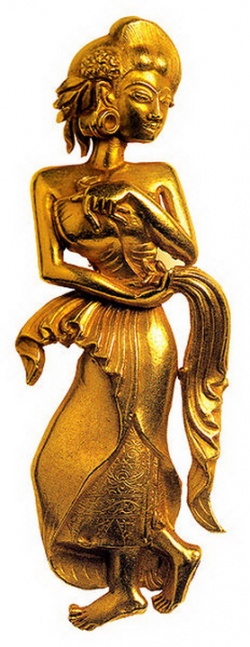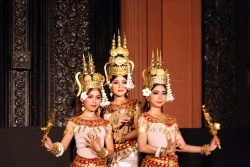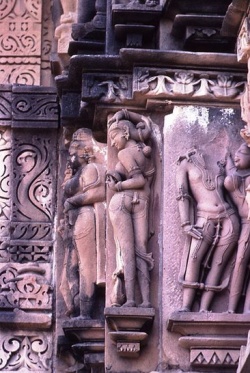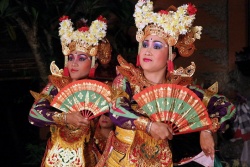Apsara
An Apsara (also spelled as Apsarasa) is a female spirit of the clouds and waters in Hindu and Buddhist mythology.
An Apsara (Sanskrit: अप्सराः apsarāḥ, plural अप्सरसः apsarasaḥ, stem apsaras-, a feminine consonant stem, អប្សរា), is also known as Vidhya Dhari or Tep Apsar (ទេពអប្សរ) in Khmer, Accharā (Pāli) or A Bố Sa La Tư (Vietnamese), Bidadari (Indonesian & Malay), Biraddali (Tausug), Hapsari or Widodari (Javanese) and Apson (Thai: อัปสร). English translations of the word "Apsara" include "nymph," "celestial nymph," and "celestial maiden."
Apsaras are beautiful, supernatural female beings. They are youthful and elegant, and superb in the art of dancing. They are often the wives of the Gandharvas, the court musicians of Indra. They dance to the music made by the Gandharvas, usually in the palaces of the gods, entertain and sometimes seduce gods and men. As caretakers of fallen heroes, they may be compared to the valkyries of Norse mythology. As ethereal beings who inhabit the skies, and are often depicted taking flight, or at service of a god, they may be compared to angels.
Apsaras are said to be able to change their shape at will, and rule over the fortunes of gaming and gambling. Urvasi, Menaka, Rambha and Tilottama are the most famous among them. Apsaras are sometimes compared to the muses of ancient Greece, with each of the 26 Apsaras at Indra's court representing a distinct aspect of the performing arts. Apsaras are associated with water; thus, they may be compared to the nymphs, dryads and naiads of ancient Greece. They are associated with fertility rites.
There are two types of Apsaras; Laukika (worldly), of whom thirty-four are specified, and Daivika (divine), of which there are ten.
The Bhagavata Purana also states that the Apsaras were born from Kashyap and Muni.
The Rig Veda tells of an Apsara who is the wife of Gandharva; however, the Rig Veda also seems to allow for the existence of more than one Apsara. The only Apsara specifically named is Urvashi. An entire hymn deals with the colloquy between Urvashi and her {{Wiki|mortal]] lover Pururavas. Later Hindu scriptures allow for the existence of numerous Apsaras, who act as the handmaidens of Indra or as dancers at his celestial court.
tennin 天人 (Skt. = Apsaras, Apsara)
Literally “Heavenly People” or “Celestial Beings.” Originated in earlier Vedic mythology. This group includes the Flying Apsara (Hiten 飛天), the Celestial Maidens (Tennyo 天女), and the Bosatsu on Clouds ([[Unchuu Kuyou[Bosatsu]] 雲中供養菩薩). Famous effigies of the latter, from the 11th century, can be found at Byōdōin Temple 平等院 in Kyoto’s Uji district. Says the Buddhism Flammarion Iconographic Guide by Louis Frederic:
“The Apsaras are celestial beings, which are not in fact deities subject to worship, but merely the servants of the Deva (Jp. = Ten). Mostly they are dancers and musicians, and were widely used for the decoration of temples and sanctuaries, especially in Thailand, Burma, and Laos. They are not specially worshipped, although people do accord them some veneration by placing flowers, water, and rice at their feet. Particularly in China and Japan, they are found standing on lotuses, or seated or standing on clouds. They are then sometimes treated as Bosatsu (Bodhisattva), as in the sculpture on the walls at the Byōdōin at Uji in Japan. They usually wear light and floating celestial garments, embellished with scarves of gauze (Jp. = Tenne), and sometimes play musical instruments.”
Mahabharata
In many of the stories related in the Mahabharata, Apsaras appear in important supporting roles. The epic contains several lists of the principal Apsaras, which lists are not always identical. Here is one such list, together with a description of how the celestial dancers appeared to the residents and guests at the court of the gods:
Ghritachi and Menaka and Rambha and Purvachitti and Swayamprabha and Urvashi and Misrakeshi and Dandagauri and Varuthini and Gopali and Sahajanya and Kumbhayoni and Prajagara and Chitrasena and Chitralekha and Saha and Madhuraswana, these and others by thousands, possessed of eyes like lotus leaves, who were employed in enticing the hearts of persons practising rigid austerities, danced there. And possessing slim waists and fair large hips, they began to perform various evolutions, shaking their deep bosoms, and casting their glances around, and exhibiting other attractive attitudes capable of stealing the hearts and resolutions and minds of the spectators.
Exploits of individual Apsaras
The Mahabharata documents the exploits of individual Apsaras, such as Tilottama, who rescued the world from the rampaging asura brothers Sunda and Upasunda, and Urvashi, who attempted to seduce the hero Arjuna.
The Nymph and the Sage
A story type or theme appearing over and over again in the Mahabharata is that of an Apsara sent to distract a sage or spiritual master from his ascetic practices. One story embodying this theme is that recounted by the epic heroine Shakuntala to explain her own parentage. Once upon a time, the sage Viswamitra generated such intense energy by means of his asceticism that Indra himself became fearful. Deciding that the sage would have to be distracted from his penances, he sent the Apsara Menaka to work her charms. Menaka trembled at the thought of angering such a powerful ascetic, but she obeyed the god's order. As she approached Viswamitra, the wind god Vayu tore away her garments. Seeing her thus disrobed, the sage abandoned himself to lust. Nymph and sage engaged in sex for some time, during which Viswamitra's asceticism was put on hold. As a consequence, Menaka gave birth to a daughter, whom she abandoned on the banks of a river. That daughter was Shakuntala herself, the narrator of the story.
Natya Shastra
Natya Shastra, the principle work of dramatic theory for Sanskrit drama, lists the following apsaras: Manjukesi, Sukesi, Misrakesi, Sulochana, Saudamini, Devadatta,Devasena, Manorama, Sudati, Sundari, Vigagdha, Vividha, Budha, Sumala, Santati, Sunanda, Sumukhi, Magadhi, Arjuni, Sarala, Kerala, Dhrti, Nanda, Supuskala, Supuspamala and Kalabha.
Indonesian and Malay culture
The term 'Bidadari' (from sanskrit vidhya dharya; 'the bearer of knowledge') is a Malay-Indonesian word that equates refer Indian concept; as heavenly maidens living in the svargaloka or in celestial palace of Indra, described in Balinese dedari (Bidadari or Apsara) dance. However after the adoption of Islam, bidadari is equated with heavenly maiden mentioned in the Quran, in which God stated that the 'forbidden pearls' of heaven are for those men who have resisted temptation and borne life's trials. Islam spread in the Malay archipelago when Arabic traders came to trade spices with the Malays; at that time, Hinduism formed the basis of the Malay culture, but syncretism with the Islamic religion and culture spawned the idea of a Bidadari. It is usually seen as a prized offer to those who lived a lifestyle in service to and pleasing to God; after death, the Bidadari was the man's wife or wives, depending on what type of person he was. The worthiness of a man who was offered Bidadari depended upon his holiness: how often he prayed, how much he turned away from the 'outside world', and how little he heeded worldly desires.
Visual arts
{{Wiki|Java]] and Bali, Indonesia
Images of Apsaras are found in several temples of ancient {{Wiki|Java]] dating from the era of the Sailendra dynasty to that of the Majapahit empire. Usually they are not found as decorative motifs but as integral parts of a story in bas-relief, as for example at Borobudur, Mendut, Prambanan, Plaosan, and Penataran. At Borobudur apsaras are depicted as divinely beautiful celestial maidens, pictured either in standing or in flying positions, usually holding lotus blossoms, spreading flower petals, or waving celestial clothes as if they were wings enabling them to fly. The temple of Mendut near Borobudur depicted groups of devatas, divine beings flying in heaven, which included apsaras.
Traditionally apsaras are described as celestial maidens living in Indra's heaven (Kaéndran). They are well known for their special task: being sent to earth by Indra to seduce ascetics who by their severe practices may become more powerful than the gods. This theme occurs frequently in Javanese traditions, including the "Kakawin Arjunawiwaha", written by mpu Kanwa in 1030 during the reign of king Airlangga. The story tells that Arjuna, in order to defeat the giant Niwatakawaca, engaged in meditation and asceticism, whereupon Indra sent apsaras to seduce him. Arjuna, however, managed to conquer his lust and then to win the ultimate weapons from the gods to defeat the giant.
Later in the Javanese tradition the apsara was also called Hapsari, also known as Widodari (from sanskrit word Vidhyadhari, vidhya: knowledge, dharya: having, bearer, or bringer), and finally known as Bidadari in the modern Indonesian language (the same form of the word is now present in the Malay language, as well). The Javanese Hindu-Buddhist tradition also influenced Bali. In Balinese dance the theme of celestial maidens often occurred. Dances such as Sanghyang Dedari and Legong depicted divine maidens in their own way. In the court of Mataram Sultanate the tradition of depicting heavenly maidens in dances still alive and well. The Javanese court dances of Bedhaya portray apsaras.
Cambodia
Apsaras represent an important motif in the stone bas-reliefs of the Angkorian temples in Cambodia (8th–13th centuries AD), however all female images are not considered to be apsaras. In harmony with the Indian association of dance with apsaras, Khmer female figures that are dancing or are poised to dance are considered apsaras; female figures, depicted individually or in groups, who are standing still and facing forward in the manner of temple guardians or custodians are called devatas.
Angkor Wat, the largest Angkorian temple built (1116–1150 AD), features both apsaras and devata, however the devata type are the most numerous with more than 1,796 in the present research inventory. Angkor Wat architects employed small apsara images (30–40 cm as seen at left) as decorative motifs on pillars and walls. They incorporated larger devata images (all full-body portraits measuring approximately 95–110 cm) more prominently at every level of the temple from the entry pavilion to the tops of the high towers. In 1927, Sappho Marchal published a study cataloging the remarkable diversity of their hair, headdresses, garments, stance, jewelry and decorative flowers, which Marchal concluded were based on actual practices of the Angkor period. Some devata appear with arms around each other and seem to be greeting the viewer. “The devatas seem to epitomize all the elements of a refined elegance,” wrote Marchal
Khmer classical dance
Khmer classical dance, the indigenous ballet-like performance art of Cambodia, is frequently called "Apsara Dance".
Champa
Apsaras were also an important motif in the art of Champa, medieval Angkor's neighbor to the east along the coast of what is now central Vietnam. Especially noteworthy are the depictions of apsaras in the Tra Kieu Style of Cham art, a style which flourished in the 10th and 11th centuries AD.
Cave art of China
Apsaras are often depicted as flying figures in the mural paintings and sculptures of Buddhist cave sites in China such as in the Mogao Caves, Yulin Caves, and the Yungang and Longmen Grottoes. They may also be depicted as dancers or musicians. They are referred to as feitian (飞天) in Chinese.



